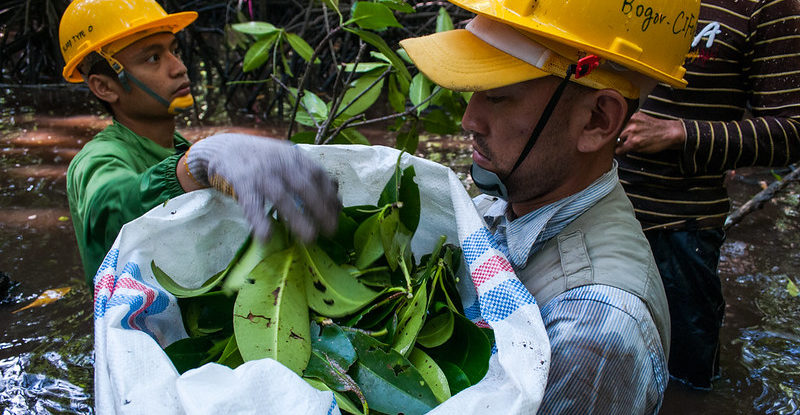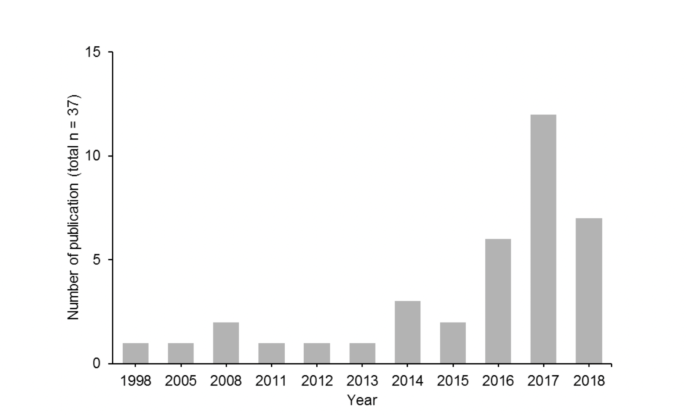
Mangrove forests are important to the livelihoods of millions of people living along coastlines, providing fish resources, protecting communities from storms and coastal erosion, and myriad other benefits.
However, these benefits are severely undervalued, so mangroves are prone to conversion to other land uses with a more immediate economic benefit. This unique wetland ecosystem continues to be lost at a rapid rate, and the impacts this mangrove loss has on the important benefits they provide is poorly known.
One particular benefit that mangroves provide is their ability to suck up carbon emissions from the atmosphere and store them as “blue carbon” in their wood and waterlogged soils. This makes mangroves an effective tool to mitigate global climate change.
But what happens to this huge amount of stored carbon when mangroves are disturbed?
In collaboration with partners we, a team of scientists from the Center for International Forestry Research (CIFOR), Australia’s Charles Darwin University, and the National University of Singapore, joined forces to form a systematic review team that explored and synthesized available evidence of the impacts of land-use and land-cover change (LULCC) on mangrove blue carbon.
We explored what happens to carbon stored in mangrove ecosystems when they are affected by conversion and human disturbance and suggest how we can better manage these marginalized coastal forests that are currently undergoing unsustainable use. We recently published our systematic review results in Global Change Biology. The work was an explicit and judicious effort to make use of current best evidence in making decisions related to goods and services from mangrove forest resources.
Crunching the numbers
Using online literature databases and search engines, we screened information from more than 5,000 journal papers and other sources. The best evidence was derived from 478 measurements from 37 publications, where a systematic review process was carried out to minimize bias. These publications reported field-based data related to carbon stocks and soil greenhouse-gas flux studies from around 20 out of 118 mangrove countries worldwide.
The number of research publications on mangroves and carbon have increased over the past five years indicating a growing research interest by the scientific community. Nevertheless, we observed that most studies we excluded during our review reported blue carbon numbers from either undisturbed or LULCC-affected sites only. This is still good news because researchers across the world are currently measuring blue carbon. However, there are certainly knowledge gaps, particularly in terms of their carbon management implications when blue carbon ecosystems are impacted by LULCC.

Number of papers published between 1998 and October 2018 included in the analysis.
From the systematic review we learned:
- Mangrove forests are subject to deforestation. We learned that there are three main land uses replacing mangrove areas worldwide, including aquaculture, pasture and agriculture. We also documented that some deforested and converted mangroves are reforested through rehabilitation and restoration programs.
- The degree of carbon stock losses is dependent upon mangrove location and when they are converted. Typical tall mangrove forests in countries in the low tropics such as Indonesia, Malaysia, Brazil, and Central Africa with greater carbon stocks will result in higher carbon loss from the conversion. Similarly, the longer the period of time since conversion will have greater carbon loss impact.
- Conversion of mangroves into aquaculture turned out to be the largest driver of total carbon stock loss (83 percent from biomass and 54 percent from soil carbon), followed by rice agriculture and pasture. Deforesting and converting them will result in emissions of nearly 450 Mg carbon or 1,652 CO2 per hectare. It means that losing one hectare of mangrove is equal to losing 3-5 ha of tropical humid forest.
- The pattern of soil greenhouse gas flux changes following mangrove conversion is still unclear. We suspect that data availability gaps are still huge for soil greenhouse gas flux assessment in mangroves. For example, we find no study was reported from Africa. While greenhouse gas flux from soil is highly varied with time and spaces.